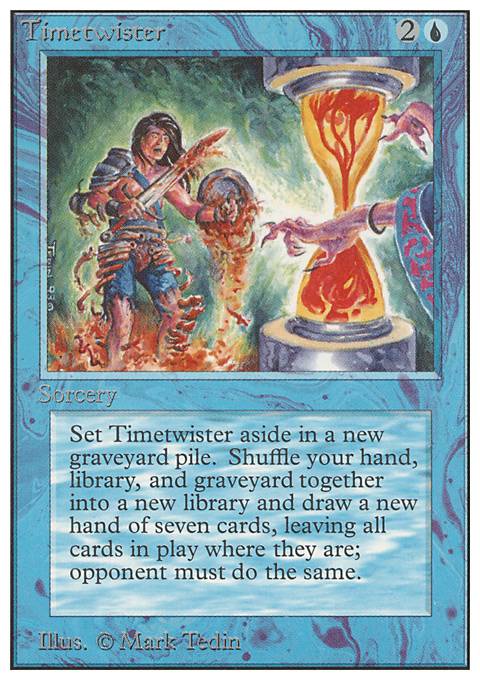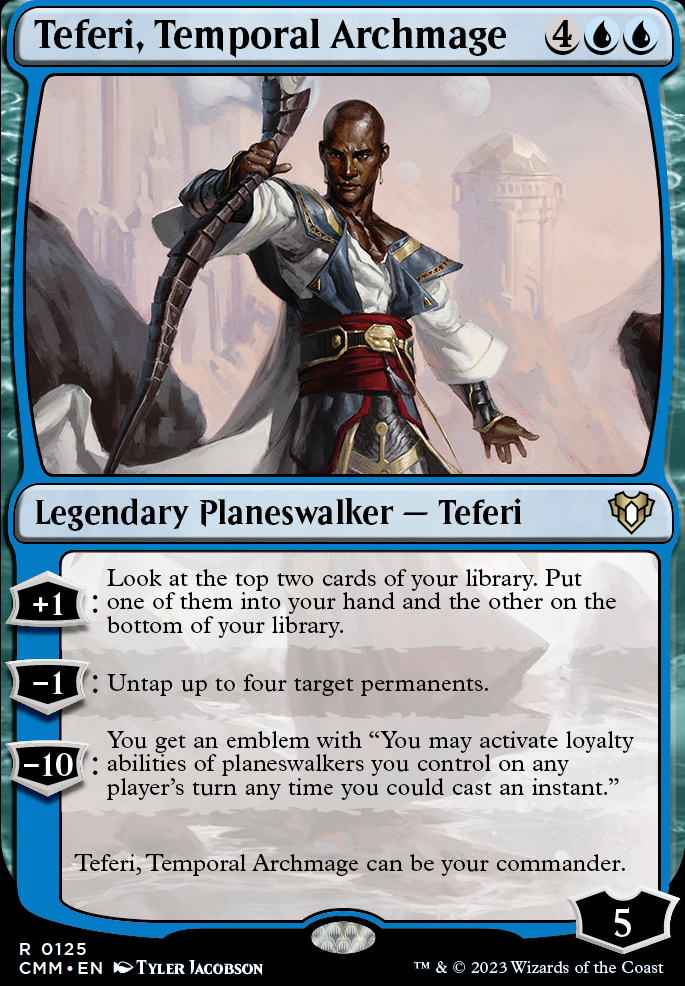Lands are really the bread and butter of every deck, no matter what. In Teferi, your lands are no exception to this, with a wide range of options, from the almighty Tabernacle at Pendrell Vale, to the subtle Seat of the Synod, the lands in Teferi are varied, useful, and situationally deadly, when the right time comes. While I will admit that some of my choices may seem a bit strange, there is a perfectly good and valid reason for each option, which, as usual, I will explain below.
Ancient Tomb
Fast mana, for a price. Ancient Tomb is pretty self explanatory. You have 40 life, this land is exceptional for producing mana for as long as you're willing to pay the toll. Note: Teferi is capable of 'going-off' with an Ancient Tomb and either the Sol Ring, or the Mana Crypt, if that's all you have. You will have to formally 'run the loop' when doing it with Ancient Tomb, though, because the Tomb can kill you before you win, so you will have to break down the combo mathematically and into interations to see if you actually get there. Personally, I would never let the risk of dying by my own blade interfere with my will to win. If I seriously don't have it, then don't start the loop, but I would say that as long as your getting ten uses of Ancient Tomb based on life total, so, at least 22 life, you should attempt to fire off the combo through your own Ancient tomb, and then while the combo is firing, simply look for a way to get your Tomb out of the picture.
Academy Ruins / (and Buried Ruins)
These are arguably the most practical lands in the entire deck for you. They has an incredibly powerful ability for what you're after, effectively making Intuition a double tutor for just three mana, and no significant drawback. I would argue that both the Ruins are actually so powerful in your deck, that you should actually consider playing either of them out early, even before you would get your traditional UU from two islands, just because of how prevalent Wheel effects are in this format. Barring rare exceptions, this is my method, based on how strong both the 'Ruins' lands are for you, and the problems they can help prevent.
Blast Zone
"You mean, I can has such a thing?" Yes, yes little blue player. Now run along and go blow something up...
Blast Zone is an exceptionally powerful land card in Teferi. It shores up a number of holes in the general game plan, and does so in a way that is difficult to interfere with. Blast Zone is excellent at managing decks that run a lot of mana-dorks, but where it really shines is it's ability to punk Null Rods. Yup, you read that right. If you haven't tried it yet, this Teferi player strongly advises you to run Blast Zone, and to use the Expedition Map to find it early, in certain match-ups, because of this interaction. Without a Blast Zone in play on resolution of a Null Rod, your only other option is to bounce the card. This will work, but only for a turn. It just so happens that three out of the four Null Rod effects available to cEDH players are at 2cmc as well, so, go have some fun with that. Hmmm, now what else gets hit at 2cmc??
Inventor's Fair
Inventor's Fair is another incredibly useful land for you for the simply reason that it's effectively an instant speed tutor to hand for artifacts. This is amazing as it provides with a tutor option that is far more difficult to interact with on the stack in cEDH. Except in rare exceptions, most of the time, I'd keep the land until you're ready to win. Heck, who knows, maybe even the life gain you get from this card might actually save you. Hint: read the whole card, and don't forget to gain your life.
Lotus Field
Lotus Field is an interesting card that I'm willing to try. On paper, it's effectively a 3tap rock that costs nothing to cast. That said, there is the drawback of having to sacrifice two lands on entry, which may seem problematic. Therefore, you will ahve to weight the merit of whether or not to run this card in your deck from an overall sense. To me, it's worth it, but I won't run it as a land. There's simply to much going on with the card for me to just call it an island and go from there. In truth, I am replacing Winter Orb with Lotus Field to try it out. The Orb is really bugging me because of the prevalence of Gaea's Cradle in our meta, effectively making the Orb a dead card in hand. I feel that running the Lotus field gives me another card to combo with, can greatly facilitate going off with what's already in the deck, and can actually reduce the impact of Carpet of Flowers in certain matchups, making it an interesting option. I will keep you posted after some heavy testing to see if it truly fits or not in the deck.
Seat of the Synod
It fetches off a Trinket Mage, is an artifact for things like Transmute Artifact, Mox Opal, or Thirst for Knowledge, and provides blue mana without feeding into a Carpet of Flowers. That said, as a nonbasic land, it is subject to every Blood Moon effect in the format, and as an artifact, it will get shut down by a Null Rod. For me, overall, the pros outweight the cons. That said, not by much, as Darksteel Citadel definitely doesn't make the cut. You choose on this one. Thirst for Knowledge and Mox Opal were significant considerations in my decision, especially the Opal.
Snow-covered Island
Honestly, two reasons for snow-covered lands. 1) I use the Ice Age ones for the picture alone. They look so drab, and I've currently got my Teferi deck in these drab silverish sleeves. The whole effect is this gloomy appearance to the deck which I find suits its nature. 2) Just once, I'm going to randomly sit down at a large table, and someone else will play an Extraplanar Lens, Imprinting: Snow-covered Island, and I will be in Heaven. It'll be a Thursday, and I'll remember it forever... ;)
You really don't need snow-covered lands though, as regular islands do the same thing. One thing to note about my 'basic' lands that's a bit different is that, I don't run fetchlands in my Teferi deck. The reason for this is because of the risk of running into Root Mazes, Mindscensors, and Strangleholds. I also find that running the fetches actually does 'require' a higher land count, which then takes away from my business spells. I will probably dabble with that new basic land fetch that just came out, just for another shuffle effect for my Sensei's Top and Brainstorm, but I probably won't go back to running the four blue fetches. It's actually quite liberating without them.
The Taberacle at Pendrell Vale
This is the mac Daddy of lands that are available in cEDH, and Teferi can abuse the card in a way that few other decks can truly realize. On it's own, this card places a free, uncounterable tax on every creature on the board. With either a Stasis, or a Back to Basics, this tax is deadly. As with my Lotus Field, I do not run my Tabernacle as a land from a deck building point of view, but consider it a card instead, as the land itself does not produce any mana. But other than that, holy cow, what a monster. Not that the other nonbasic lands in the deck wouldn't be reason enough on their own merit, but man, let me tell you: Expedition Map and The Tabernacle at Pendrell Vale were made for each other in cEDH.





